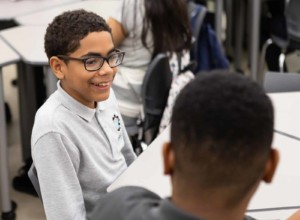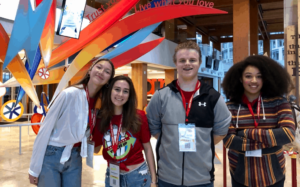20 Schools Innovating With Digital Tools

Co-written by Tom Vander Ark and Sarah Cargill
Hans Renman in Stockholm (@tankom_hans) asked on Twitter, “Do you know any US schools that are REALLY using digital tools in an INTERESTING way for communication, marketing, or learning?” That tweet kicked off a few days of snooping around. Here is the list of 20 we came up with. We look forward to your additions!
1. Show & Tell. High Tech High does a great job using video to showcase its unique project-based learning model schoolwide. Ninth graders produce a film festival.
2. Visual math. About 1,400 schools use the visual game-based ST Math featuring JiJi the penguin. For example, the Orange County math initiative tripled math proficiency.
3. Student motivation. Innosight’s Heather Staker says Acton Academy in Austin puts motivation first. Acton turned to programs like Dreambox,Khan Academy, Mangahigh, andST Math for high engagement.
4. Classroom assessment. As featured in a recent Getting Smart blog, the staff at Leadership Public Schools in Oakland built Exit Ticket, a classroom assessment and competency tracking system. LPS is the best example of a collaborative and distributed innovation agenda across a network of schools.
5. Adaptive learning. Public Schools (PS) 49 in Bronx, NY used i-Ready to provide differentiated and personalized instruction in a blended rotation model to build reading skills. Within just 14 weeks, more than three times as many students using i-Ready were scoring on or above grade level in reading.
6. Flipped school. Greg Green is principal of Clintondale High School in Michigan. They flipped much of their instruction using content on Gooru. Learn more about Clintondale on The Flip Institute blog.
7. Game-based learning. Quest to Learn (Q2L) is a game-based NYC middle school where kids learn through design and complex problem solving in a learning by doing environment. According to Q2L, classes are challenging, immersive, and game-like learning experiences for students.
8. Portable learning. Gold medal gymnast Aly Raisman is a Florida Virtual School student and took her learning on the road.
9. Competency-based learning.Flex model schools, like Silicon Valley Flex, use a digital curriculum to support individual progress. Kunskapsskolan, a Swedish school network, which was recently described in a Getting Smart blog, uses technology to support individual goal setting. See CompetencyWorks for more on this topic.
10. Project-based learning. The 100-school Edvisions high schools use Project Foundry and a variety of tools to support project-based learning and authentic assessment.
11. Augmented reality. Chris Dede at Harvard University is piloting augmented reality (AR) science field trips with Chappaqua, New York public schools. Read more about Dr. Dede’s work on Getting Smart. (And, by the way, we are very enthusiastic about the potential of AR to turn a walk around the block into a powerful social studies, economics, history, as well as science field trip experience.)
12. Personal Learning Network (PLN). New Milford High School Principal Eric Sheninger (@NMHS_Principal) learned a lot from his PLN. His network taught him to transform the way he communicates and the way the school interacts with the community. Read Eric’s greatHuffingtonPost summary.
13. Parent engagement. Rocketship Education‘s Facebook page is almost completely run by parents. Each school has a social media leader who is responsible for posting information, events, photos, and video for their school. (For more, Alision Anderson described 10 family engagement strategies in this Getting Smart blog.)
14. Rich Multimedia. Rocketship Education fifth graders create a multi-page report and 5-minute presentation about a global challenge on Google Docs word processor and presentation programs with Chromebooks for laude, cum laude or summa cum laude recognition. With Google Docs, students also collaborate with peers and advisors across the country in real time on documents and email.
15. Travel. THINK Global School students use the latest equipment to “record, report, and share their global education online as they travel the world.”
16. Challenge. NYC iSchool blends computer adaptive learning with challenges that require students to work together to present real solutions to real problems.
17. Art. Ypsilanti New Tech students create 3-D designs on tablets, then turn the works into 2-D photo images, which they can add brush strokes to make digital art.
18. Citizenship. New Tech Odessa leverages tech in a deep way. The school uses Facebook, Twitter, YouTube and other mediums to build trust and teach social media responsibility and digital citizenship.
19. PoliSci. Eagle Tech Academy created a New Tech Network-wide project titled #myparty12. This project asks each kid to create their own political party. Each party will have to defend a policy, create a 30 second campaign video, the top five will debate and eventually the debate will take place online. They will be using Echo, the New Tech PBL LMS, email, Google email and Google Docs to work collaboratively. Social media will play a large part in this project. It will be exciting to watch the twitter stream, Facebook pages and YouTube videos.
20. Heart. Mooresville, North Carolina superintendent says, ” It’s not about the machine, it’s about heart,” but his students sure make great use of their MacBooks. The innovation in Mooresville is the system–expectations, culture, curriculum, tools, and support.
Disclosure MIND Research Institute, FLVS and Curriculum Associates are Getting Smart Advocacy Partners.








Megan
San Marcos School District in Texas is using iPods to help English Language Learners. Songs, videos, and lessons are all loaded onto the iPods so students can review lessons and practice at home. http://www.districtadministration.com/article/learning-personal-media-players
They are also using Macbooks to aide teacher instruction in math classes. After each lesson, students record themselves answering questions about the lesson. Teachers are then able to review the videos and find the holes in their lessons to ensure all students understand the lesson. http://smmercury.com/2008/12/10/smcisds-ronda-stonecipher-named-innovator-of-the-year-again/
Concerned Parent
This list is great and companies like Dreambox are amazing but there is one thing missing and it is amazing to me given your position as the leader of iNACOL.
The companies that provide online curriculum namely K12 (the largest nationally) are not mentioned at ALL is that because they are not doing anything innovative or because their test scores are well below their demographically similar peers, like the study from the National Education Policy Center shows (nepc.colorado.edu/files/nepc-rb-k12-miron.pdf).
This is now even in your estimation showcasing that the largest FOR-PROFIT provider is NOT meeting the needs of the masses they service or more like provide a disservice to...amazing to me to see the truth in your blog.
Finally though you have come clean that they are not doing anything innovative or out of the box. Even though they invest in new curriculum, new programs and new models they don't make many lists nationally or otherwise.
I am glad there are small start-ups to show the big box companies how it can be done and how we can improve student performance.
Thanks Tom for showing us the truth!
prithviinspire
The game based learning is always helpful than whatever we do; it will reach all the age groups both kids and teen age people especially. If they got interested in the concept of gaming they will learn the things easily.
walden student 1
Hello,
Thank you for sharing this information because I like to stay current in technology trends. I just read a blog about gaming as a learning tool so this was very interesting. I like how not only did you share that the schools are using this technology but you backed it up with data to support the use and funding. Students are reading on grade level and improving math score that will support funding for sure.
Tom Vander Ark
Quick response to 'parent': #9 features a K12 school.
NEPC runs sponsored hit pieces not research. Here is a thoughtful response to their last piece by Robin Lake:
http://www.gettingsmart.com/gettingsmart-staging/edreformer/online-learning-studies-must-evaluate-individual-student-trajectories/
Here's my response to their so-called compilation:
http://www.gettingsmart.com/gettingsmart-staging/blog/2012/01/educational-management-organizations-the-rest-of-the-story/
My post this week reflects iNACOL's leadership on quality options for kids & families:
http://www.gettingsmart.com/gettingsmart-staging/blog/2012/08/better-learning-online/